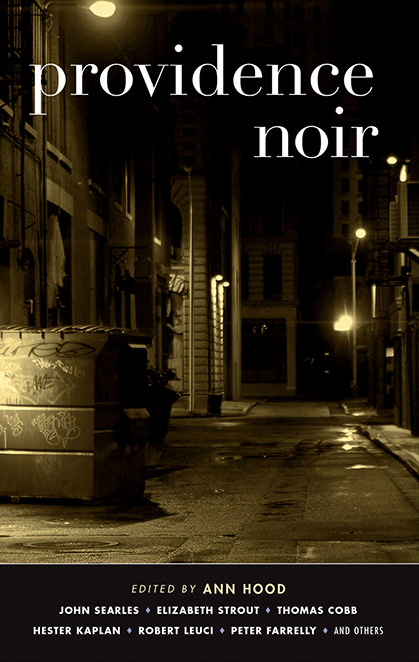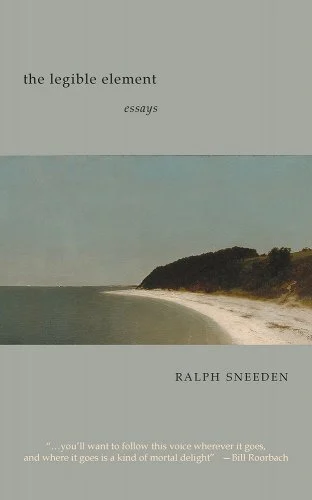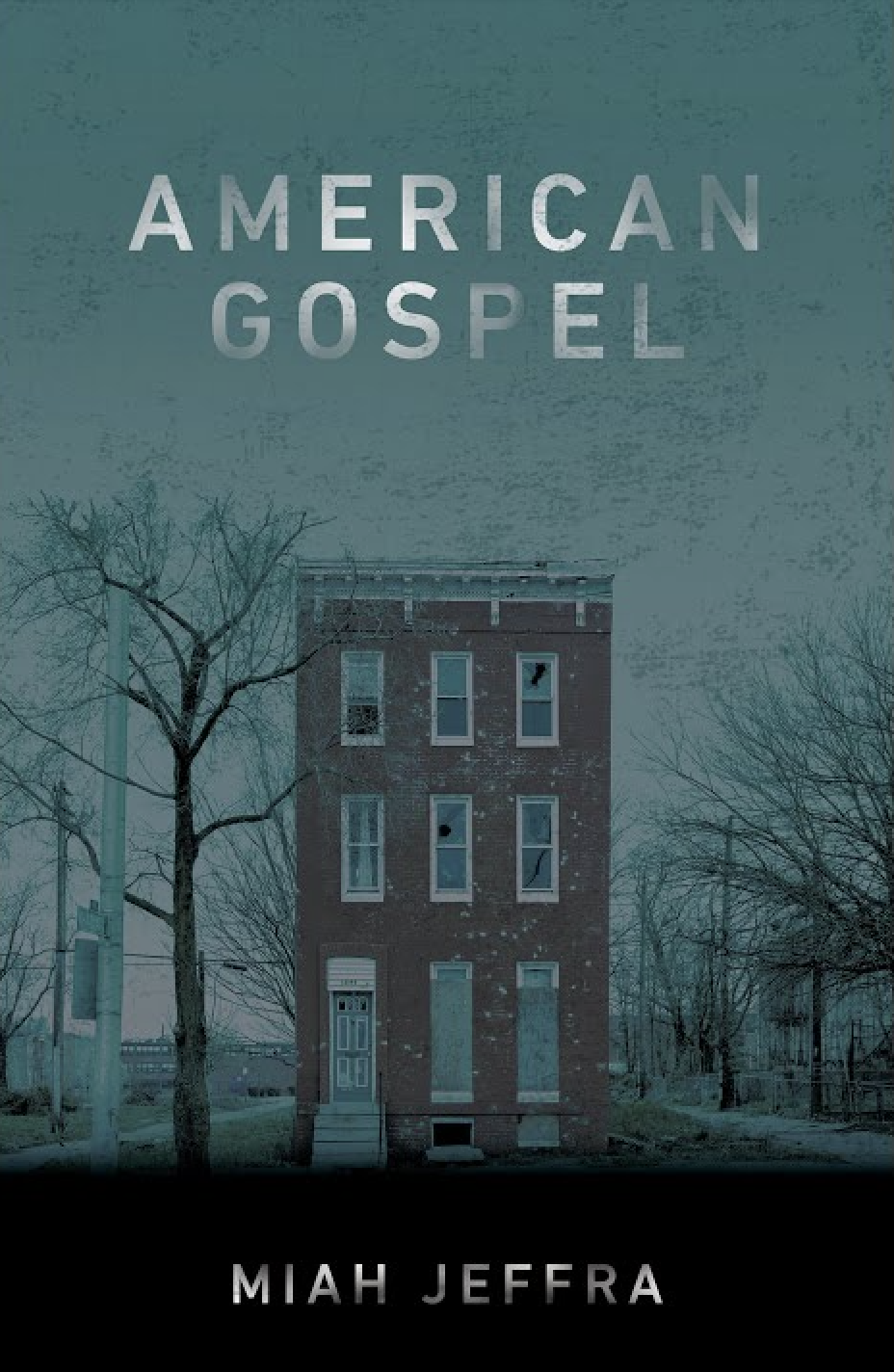Book by ANN HOOD, ELIZABETH STROUT, PETER FARRELLY, BRUCE DESILVA, MARIE MYUNG-OK LEE, ROBERT LEUCI, DAWN RAFFEL, LUANNE RICE, THOMAS COBB, JOHN SEARLES, TAYLOR M. POLITES, PABLO RODRIGUEZ, AMITY GAIGE, LASHONDA KATRICE BARNETT, HESTER KAPLAN
Reviewed by

Noir is not my regular genre. But I have read my fair share of Raymond Chandler, and I’ve seen The Big Sleep more than once. I’m from Brooklyn originally—Noir Central—and I’ve lived in Rhode Island for over 20 years. So I jumped at the opportunity to review Providence Noir, Brooklyn-based Akashic Books’s latest entry in its 11-year-old Noir series, atmospheric story collections set in cities all over the world.
Part of the fun of reading the series is imagining familiar landmarks in a sinister light. The appropriately mysterious cover photo of Providence Noir looks out on a deserted Dorrance Street, in the city’s old center, from an alley behind the Union Trust Company at night. The sidewalk looks wet where the streetlight falls. Might be rain, might be blood. We also see Coffee Exchange, Central High, Trinity Rep. Benefit Street, Adler’s Hardware, India Point Park. These are the places where we Providence folk overcaffeinate, or teach, or take our kids to watch A Christmas Carol. Places where we try to find parking for jury duty, pick up paint to brighten the kitchen, buy freshly made pasta, enjoy one more late summer picnic. Turned by the writers ofProvidence Noir into sites of intrigue, mayhem, and death, they make the little reptilian hairs on the back our necks rise, as if suddenly we find ourselves inside the fiction on the page.
Rhode Island owes its existence to “a rogue named Roger Williams,” who “escaped” after “Massachusetts was ready to deport him back to England,” in the words of Ann Hood, the collection’s editor and a contributor. Noir stories are about “villains, not heroes,” Hood notes. Not all the protagonists of the 15 stories in Providence Noir are villains exactly, but they’re not heroes either. They’re Providence characters. Providence may have more than its share of politicians gracing our prisons and families whose patriarchs make offers we can’t, or shouldn’t, refuse, and 29% of its population is below the poverty level, but the capital of the nation’s smallest state is also home to the Rhode Island School of Design and Brown University, and a racial and ethnical mix that includes Portuguese, Azoreans, African-Americans, Italians, and Yankees. The Columbus Theater, once an X-rated movie theater, even hosted its first TEDx Providence—the local version of the TED arts and technology conferences.
The mood of these stories accrues like interest on an underwater mortgage. There are sudden rainstorms, windswept riverbanks, smoke that smells of flesh.
There’s plenty of humor, much of it wry. In Luanne Rice’s opening piece, “Gold Leaf,” an artist, a former RISD student, uses “thousands of 23-karat sheets, as fine and fragile as moth wings, mail-ordered from the same Florence studio that had supplied Fra Angelico in the fourteenth century” to paint portraits of local politicians as religious figures, sporting unearned halos. Mistress to a married lobbyist, her artistry backfires after she seduces a neighbor whose jealousy proves greater and more lethal than her own. In Thomas Cobb’s “$1,000 Nassau,” the life of hustler Bobby hangs on whether he can locate the “Titleist black three, two blue dots” that will convince his marks he’s not trying to cheat them. John Searles’s story, “The Pig,” is named for the “bright pink, pig-shaped, ceramic cookie jar” we’re led to believe contains his wife’s ashes.
Amity Gaige’s “The Autobiographical House” is narrated by a Brown undergrad from Woonsocket, “a community… full of the passions of any semi-isolated cultural subgroup on the economic downslope.” She is out of place among her better-educated, wealthier peers, but determined to succeed. She enrolls in a popular course taught by a Viennese architecture professor, with whom she stays involved, though their relationship began after he raped her. The story is told in retrospect; she refers to her time with the professor as “a marathon of denial.” In their third year together, she has a revelation: “I know that [a relationship] implies two people with individual wills meeting one another in some kind of mutually-agreed-upon psychic territory… But then there are relationships that mimic relationship, and even if you are one of the parties involved, you have no clue that you are not, in fact, in a relationship. You are in a kind of excruciatingly convincing performance.” Providence’s architecture, as the title implies, is both setting and symbol. As the power in the relationship shifts, the action moves from Brown’s upscale, hilltop campus to the leaky, neglected Armory building, a magnificent, 165,000-square foot Gothic wreck of yellow brick, copper flashing, granite carvings, with two towers and a large drill hall under 90-foot ceilings, which Rhode Island voters declined to repair. As she considers revenge, the narrator realizes the old building will “never be renovated because there is something wrong about it, something dark and un-American. It brings to mind torture.” How convenient. A case of civic neglect turns victim to victor, if revenge is victory.
LaShonda Katrice Barnett’s “Waltz Me Once Again” features 73-year-old Cape Verdean Min and her wife, Gussie. The couple live comfortably in their 1886 Greek Revival home in Providence’s Mount Hope section (optimistically called “an urban melting pot” in a recent Providence Journal article) until Gussie dreams that Min has shot R.C., a former student and neighbor who has problems, crack or alcohol. The dream recurs; Min blames the heavy meals Gussie sneaks at night. Late one night, R.C. breaks into their house. He’s searching for valuables to sell when Gussie finds him in the kitchen. R.C. is not any old burglar. He had a crush on one of the women once. He wants their prize possessions. Race, sexuality, and class all come into play as Min tries to forestall an enactment of Gussie’s nightmare.
Hester Kaplan’s “Femur” is the eighth story of the collection and perhaps the most literary. The story benefits from its placement in the middle of the book. The mood and tone of the others offset it like a diamond on a bed of velvet. Gordon’s father is easygoing most mornings, but by the end of the day a darker mood always overtakes him, which could explain why ten years ago his wife left him, and now his girlfriend, Ellen, has disappeared. 17-year-old Gordon has been caught vandalizing the cafeteria windows of Butler Hospital, the psychiatric hospital off Providence’s picturesque Blackstone Boulevard where his father works as a psychiatrist. Gordon’s punishment for the vandalism is 40 hours of outdoor clean-up work. Clearing shrubs on the bucolic hospital grounds, Gordon slips and falls down the brambly embankment of the Seekonk River.
He clawed his way through the chaotic density, ankles torn by thorns…sorry now that he mostly knew what was right but he always did the wrong thing anyway, sorry that he’d been kicked out of two schools, that his mother didn’t like him enough to live on this continent or talk to him, that even Ellen was gone, gone, gone. …Sometimes—sometimes, he felt like nothing more than someone’s careless exhale.
To “stop his idiot tears,” Gordon thrusts his hands into the soil and, to his surprise and dismay, he pulls out a bone. “Eighteen inches long, knobbed at both ends, a silvery, porous white,” it “lay there with the certainty of something wicked and secretive.” Gordon suspects his father of foul play. This is, after all, noir, and his father “radiated a disheartening stink: something cheap and sweet, like soap from a gas station bathroom.” Angry and frightened, Gordon imagines “his unattached heart out bobbing on the Seekonk River’s surface, tepidly hopeful air keeping it afloat for a minute before it sank, the people in the loony bin watching the drowning without emotion.” Kaplan’s story ends with Gordon desperately searching the halls of Butler for a door that will open. More lost than ever, Gordon finds himself caught in that noir place, where the perpetrator might be the very person he needs most.
While each story anchors us in the particulars of Providence, some go a step further and bring in a secondary but vividly evoked location. WaterFire is the setting for Pablo Rodriguez’s “WaterFire’s Smell Tonight.” WaterFire is a 20-year-old free public event that takes place twice a month from May to November in Waterplace Park where the Providence, Woonasquatucket, and Moshassuck Rivers meet. A hundred bonfires are lit in floating braziers from gondolas carrying men and women dressed in black. Music wafts from huge speakers over crowds of people strolling the sidewalks and arched bridges. There are street performers, vendors of food, drink, clothing, craftware. For the spectator, there can be something almost spiritual in the peaceful event, which goes from sundown to midnight. Or something noir.
In Rodriguez’s story, Jose Cadalzo is lucky enough to “finally land… a volunteer job on the boat that went around the floating fire pits, feeding the pyres with crisp, specially chosen wood, giving him the best seat in the house for the now world famous Providence tradition.” Jose was best friends with Luis, “second generation, born here from a Dominican couple whose skin color was a reminder of the omnipresence of Haitians on the island of Hispaniola, the shared landmass comprising the two countries.” Three days ago the two young men argued about a “change in the Dominican constitution revoking citizenship for descendants of Haitians living in La Republica, retroactively to 1929.” The argument escalated into a fight that nearly destroyed Club Juan Pablo Duarte, a popular Dominican gathering place. Soon after the fight, Luis disappears. Noir wraps itself around the politics of identity as Jose, who knows more about Luis’s disappearance than he’s willing to admit, claims not to to understand why WaterFire’s smoke has a different smell that night, until he recalls how the owners of cows and horses dead on the road in the Dominican Republic where he grew up “would douse them with gasoline and set them on fire.”
In Taylor M. Polites “Armory Park,” Cal, born in an “East Bay town with colonial charm and a working-class core,” finds himself in a relationship with Westchester-born, Brown grad student Laura. The couple move to the Armory District, where
…there was a Hmong church across the park. There were black and Latino families along with Italians and Poles who had been in the neighborhood for decades… Liberian men played soccer in the mornings, screaming over fouls. White urban hipsters played kickball on Saturdays with stereo systems and kegs of Narragansett beer.
Cal, narrating, tells us Laura “went for fads” and wanted an “edgy neighborhood” where she could also keep chickens. But as soon as a man’s body is discovered in an old black Caprice, engine running, outside their apartment (“The chickens cackled. The police radios cackled back.”), Laura grows moody and distant, and wants to break their lease. Soon after, a roaming animal attacks the chickens at night, and in the midst of the carnage, Laura reveals she’s pregnant. Cal shores up the cage so “nothing living, not even a mouse, could squeeze in.” Rhode Island’s state motto, “Hope,” feels ironic in the context of this story. He’ll do the right thing, marry her. But he’s furious with resentment. “Things seemed to be spinning out of control. It was this neighborhood. The people. The dark streets.” And his resentment makes him dangerous. The last time we see Cal, he’s walking their dog. He imagines letting Elmo go, imagines the dog hit by a car or picked up and forced into dogfights. He doesn’t free the dog, but we see how brutally he yanks at the leash, and how badly the dog stumbles.
Ann Hood, Elizabeth Strout, Peter Farrelly, Bruce DeSilva, Marie Myung-Ok Lee, Robert Leuci, Dawn Raffel round out the stellar cast of writers. It would have been interesting to see stories that reach back to the original population of Narragansett, the infamous rum and slave trade, the once-thriving silver and textile manufacturing days, and the 1938 hurricane that flooded downtown and destroyed the oyster industry. Fodder for a second volume.
Meanwhile, the stories in Providence Noir merit multiple readings. Then, if you’re not already here, pay a visit. You can come by train. The Providence station is not quite as ghostly as Raffel’s terrific metafiction “Training” suggests. Or maybe it is.
Susan Tacent has been published in Dostoevsky Studies, The Keats-Shelley Journal, The MacGuffin, Ontario Review, Blackbird, and DIAGRAM, among other journals.



